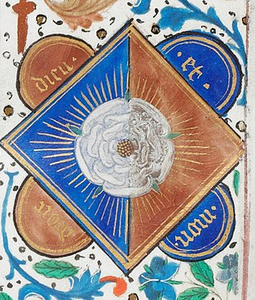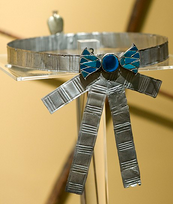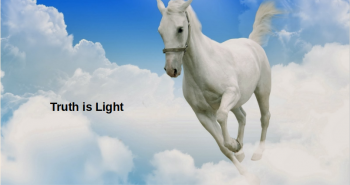Jesus unveiled a whole lot about the first & second seals of the Revelation: The white and red horses and their horsemen. Many Christians though, have produced their own "unveiling" when it comes to the meaning of the white horse and its horseman.
Revelation 1:1
"The revelation (apocalypse, i.e unveiling) of Jesus Christ, which God gave him to show his servants what must happen very soon. He made it clear by sending his angel to his servant John."
There are two types of crowns mentioned in the New Testament, both of which appear in the Revelation:-
(a) stéphanos [StrongsGreek Dictionary] 04735
STE/FANOS στέφανος stéphanos stef'-an-os from an apparently primary στέφω stéphō, (to twine or wreathe);

A stéphanos is defined as a chaplet (as a badge of royalty, a prize in the public games or a symbol of honor generally; but more conspicuous and elaborate than the simple fillet, 1238), literally or figuratively:--crown.
Royal badge:

In centuries past, royal badges (which had many different uses) could be bestowed by a monarch upon others, for example the owner of an inn who enjoyed royal patronage. The royal badge would be displayed proudly for example on a wall, showing all the other patrons that the owner of the inn enjoyed the king's patronage. It was an honor for a non-royal to be able to display it. Royal badges had many different designs.
More recently, souvenir button badges were sold to the public to commemorate the Platinum Jubilee of Queen Elizabeth II. The origin of the idea of souvenir button badges is the royal badges of old.
The origin of the stéphanos crown was the wreathe bestowed by the monarch upon victorious athletes in the ancient Greek games, which was worn on the head. Hence the stéphanos was a symbol of honor upon the head of the one who wore it.
(b) diádēma (Royal diadem, crown of authority: Diadem - Wikipedia)
[StrongsGreek Dictionary]
01238
διάδημα diádēma, dee-ad'-ay-mah
from a compound of 1223 and 1210; a "diadem" (as bound about the head):--crown.

Image licensed under the Creative Commons Attribution-Share Alike 2.0 Generic license.
The New Testament verses where the two words are used tell us a lot about the difference implied in the New Testament regarding the meaning of the two types of crown:-
1 Corinthians 9:24-25
"Do you not know that all the runners in a stadium compete, but only one receives the prize? So run to win. Each competitor must exercise self-control in everything. They do it to receive a perishable crown [stéphanos], but we an imperishable one."
The above verses tell us that Paul understood a stéphanos to be a prize bestowed upon those who were victorious. So it shouldn't be surprising to us that wherever the word stéphanos is found in the New Testament, honor and victory are associated with it:-
James 1:12
"Blessed is the man that endures temptation: for when he is tried, he shall receive the crown [stéphanos] of life, which the Lord has promised to them that love him."
Naturally, receiving the stéphanos crown implies someone else with a higher rank bestowing it upon those who receive it. (It's not a mark of royal authority like the diádēma, though the unveiling of Jesus Christ calls those who believe in Him and belong to Him "kings and priests to God" (Revelation 1:5-6).
The word stéphanos (crown) is used in the same sense that it is used in the above verses (in reference to the crown bestowed upon those who believe in Jesus) in:-
Philippians 4:1; 1 Thessalonians 2:19; 2 Timothy 4:8; and 1 Peter 5:4; and in the Revelation, in Revelation 2:10; and Revelation 3:11.
In addition, stéphanos crowns are bestowed upon the following entities mentioned in the Revelation:-
Revelation 12:1 (crown of 12 stars on the head of the woman who had given birth to the Messiah);
Revelation 4:4 & Revelation 4:10 (the crowns on the heads of the 24 elders).
Revelation 14:14 (the crown worn by the Son of man) * See note (i) further below.
The locusts of the fifth trumpet that come out of the bottomless pit are also wearing something that has the appearance of stéphanos crowns, but though they look like the real thing, they are not the real thing:
Revelation 9:7: "And the shapes of the locusts were like unto horses prepared unto battle; and on their heads were as it were crowns [stéphanos] like gold, and their faces were as the faces of men."
The word diádēma (royal diadem, crown of authority) does not carry the same meaning as stéphanos:
* The crowns on the heads of the dragon in Revelation 12:3 and the ten kings in Revelation 13:1 are diádēma.
* In Revelation 19:12 Christ is crowned with MANY diádēma. In this passage He is being called "King of (all) kings and Lord of (all) Lords" (Revelation 19:16).
* Note (i): JOHN SEES JESUS WEARING BOTH TYPES OF CROWN
In Philippians 2:6-9 we read that Jesus,
"being in the form of God, thought it not robbery to be equal with God, but made Himself of no reputation, and took upon Himself the form of a servant, and was made in the likeness of men.
And being found in fashion as a man, He humbled Himself and became obedient unto death, even the death of the cross.
Therefore God has highly exalted Him, and has given Him a name which is above every name, that at the name of Jesus every knee should bow, of heavenly ones, and of earthly ones, and of ones under the earth; and that every tongue should confess that Jesus Christ is Lord, to the glory of God the Father."
And in Acts 17:31 we read that God,
"has set a day on which he is going to judge the world in righteousness, by a man whom he designated, having provided proof to everyone by raising him from the dead.".
This will help us to understand why, whereas Jesus is seen crowned with a stéphanos crown in Revelation 14:14, where He is being called one like the Son of man, and is seen gathering His harvest at the close of the Age,
in Revelation 19:12 He is seen crowned with MANY diádēma. In this passage He is being called "King of (all) kings and Lord of (all) Lords" (see also Revelation 19:16), and is coming with His armies to defeat the beast and destroy him in the lake of fire, and take up His Kingly rule to reign.
Jesus is the only one to be seen wearing both types of crown in the Revelation.
This subject is continued in post #2 - the second part of this subject.
Revelation 1:1
"The revelation (apocalypse, i.e unveiling) of Jesus Christ, which God gave him to show his servants what must happen very soon. He made it clear by sending his angel to his servant John."
There are two types of crowns mentioned in the New Testament, both of which appear in the Revelation:-
(a) stéphanos [StrongsGreek Dictionary] 04735
STE/FANOS στέφανος stéphanos stef'-an-os from an apparently primary στέφω stéphō, (to twine or wreathe);

A stéphanos is defined as a chaplet (as a badge of royalty, a prize in the public games or a symbol of honor generally; but more conspicuous and elaborate than the simple fillet, 1238), literally or figuratively:--crown.
Royal badge:

In centuries past, royal badges (which had many different uses) could be bestowed by a monarch upon others, for example the owner of an inn who enjoyed royal patronage. The royal badge would be displayed proudly for example on a wall, showing all the other patrons that the owner of the inn enjoyed the king's patronage. It was an honor for a non-royal to be able to display it. Royal badges had many different designs.
More recently, souvenir button badges were sold to the public to commemorate the Platinum Jubilee of Queen Elizabeth II. The origin of the idea of souvenir button badges is the royal badges of old.
The origin of the stéphanos crown was the wreathe bestowed by the monarch upon victorious athletes in the ancient Greek games, which was worn on the head. Hence the stéphanos was a symbol of honor upon the head of the one who wore it.
(b) diádēma (Royal diadem, crown of authority: Diadem - Wikipedia)
[StrongsGreek Dictionary]
01238
διάδημα diádēma, dee-ad'-ay-mah
from a compound of 1223 and 1210; a "diadem" (as bound about the head):--crown.

Image licensed under the Creative Commons Attribution-Share Alike 2.0 Generic license.
The New Testament verses where the two words are used tell us a lot about the difference implied in the New Testament regarding the meaning of the two types of crown:-
1 Corinthians 9:24-25
"Do you not know that all the runners in a stadium compete, but only one receives the prize? So run to win. Each competitor must exercise self-control in everything. They do it to receive a perishable crown [stéphanos], but we an imperishable one."
The above verses tell us that Paul understood a stéphanos to be a prize bestowed upon those who were victorious. So it shouldn't be surprising to us that wherever the word stéphanos is found in the New Testament, honor and victory are associated with it:-
James 1:12
"Blessed is the man that endures temptation: for when he is tried, he shall receive the crown [stéphanos] of life, which the Lord has promised to them that love him."
Naturally, receiving the stéphanos crown implies someone else with a higher rank bestowing it upon those who receive it. (It's not a mark of royal authority like the diádēma, though the unveiling of Jesus Christ calls those who believe in Him and belong to Him "kings and priests to God" (Revelation 1:5-6).
The word stéphanos (crown) is used in the same sense that it is used in the above verses (in reference to the crown bestowed upon those who believe in Jesus) in:-
Philippians 4:1; 1 Thessalonians 2:19; 2 Timothy 4:8; and 1 Peter 5:4; and in the Revelation, in Revelation 2:10; and Revelation 3:11.
In addition, stéphanos crowns are bestowed upon the following entities mentioned in the Revelation:-
Revelation 12:1 (crown of 12 stars on the head of the woman who had given birth to the Messiah);
Revelation 4:4 & Revelation 4:10 (the crowns on the heads of the 24 elders).
Revelation 14:14 (the crown worn by the Son of man) * See note (i) further below.
The locusts of the fifth trumpet that come out of the bottomless pit are also wearing something that has the appearance of stéphanos crowns, but though they look like the real thing, they are not the real thing:
Revelation 9:7: "And the shapes of the locusts were like unto horses prepared unto battle; and on their heads were as it were crowns [stéphanos] like gold, and their faces were as the faces of men."
The word diádēma (royal diadem, crown of authority) does not carry the same meaning as stéphanos:
* The crowns on the heads of the dragon in Revelation 12:3 and the ten kings in Revelation 13:1 are diádēma.
* In Revelation 19:12 Christ is crowned with MANY diádēma. In this passage He is being called "King of (all) kings and Lord of (all) Lords" (Revelation 19:16).
* Note (i): JOHN SEES JESUS WEARING BOTH TYPES OF CROWN
In Philippians 2:6-9 we read that Jesus,
"being in the form of God, thought it not robbery to be equal with God, but made Himself of no reputation, and took upon Himself the form of a servant, and was made in the likeness of men.
And being found in fashion as a man, He humbled Himself and became obedient unto death, even the death of the cross.
Therefore God has highly exalted Him, and has given Him a name which is above every name, that at the name of Jesus every knee should bow, of heavenly ones, and of earthly ones, and of ones under the earth; and that every tongue should confess that Jesus Christ is Lord, to the glory of God the Father."
And in Acts 17:31 we read that God,
"has set a day on which he is going to judge the world in righteousness, by a man whom he designated, having provided proof to everyone by raising him from the dead.".
This will help us to understand why, whereas Jesus is seen crowned with a stéphanos crown in Revelation 14:14, where He is being called one like the Son of man, and is seen gathering His harvest at the close of the Age,
in Revelation 19:12 He is seen crowned with MANY diádēma. In this passage He is being called "King of (all) kings and Lord of (all) Lords" (see also Revelation 19:16), and is coming with His armies to defeat the beast and destroy him in the lake of fire, and take up His Kingly rule to reign.
Jesus is the only one to be seen wearing both types of crown in the Revelation.
This subject is continued in post #2 - the second part of this subject.
Last edited:


